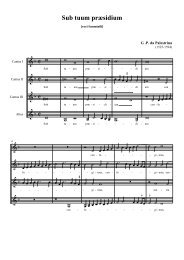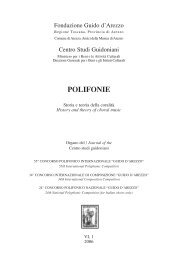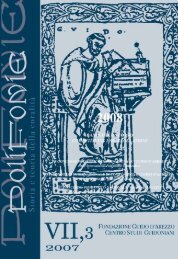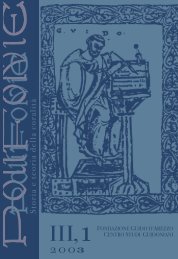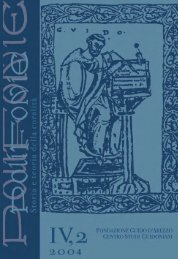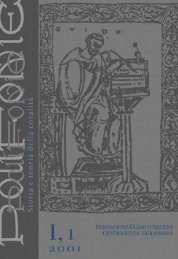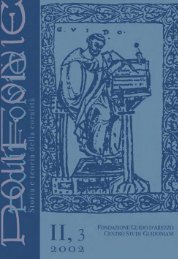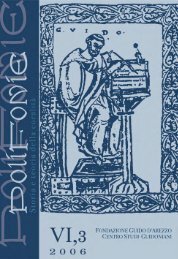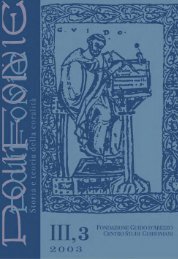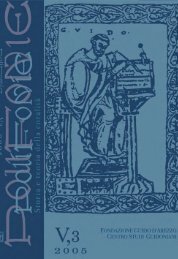Riviste Polifonie/119_2005 n 2.pdf - Fondazione Guido d'Arezzo
Riviste Polifonie/119_2005 n 2.pdf - Fondazione Guido d'Arezzo
Riviste Polifonie/119_2005 n 2.pdf - Fondazione Guido d'Arezzo
Create successful ePaper yourself
Turn your PDF publications into a flip-book with our unique Google optimized e-Paper software.
MARCO GOZZI<br />
Venice : Angelo Gardane, 1597.<br />
Canzonette a tre voci di Horatio Vecchi, et di Gemignano Capi Lupi de Modona. - Nuremberg<br />
: Paul Kauffmann, 1597.<br />
Convito musicale di Horatio Vecchi da Modona. Madrigali e canzonette a III, IIII, V, VI, VII et<br />
VIII voci. Novamente composto, et dato in luce. - Antwerp : Pierre Phalèse e Jean Bellère,<br />
1598.<br />
Canzonette d i Horatio Vecchi da Modena, libro terzo a quattro voci. - Venice : Angelo Gardane,<br />
1600.<br />
Canzonette a quattro voci di Horatio Vecchi da Modena, la quali per avanti sono in Venetia<br />
spartatamente ite in luce, et ora per più comodità raccolte insieme. E con aggiunta di altre<br />
a 5, 4 e tre voci - Nuremberg : Paul Kauffmann, 1600.<br />
Asking Vecchi must have seemed the most natural course to Gardano. It<br />
was the period when the composer was moving from Reggio Emilia to Correggio,<br />
and it is probably as a canon of Correggio that he worked on the revision<br />
of the Gradual.<br />
If this hypothesis is correct, we can assume that Vecchi’s work was grafted<br />
onto that of Gabrieli. It is not known how much Gabrieli had already done,<br />
but there is evidence that suggests that the revision of the Gradual was done<br />
separately by the various editors, over various years and using dissimilar criteria.<br />
Perhaps Gabrieli began with the Kyriale and also revised a part of the<br />
proprium de tempore, after which Vecchi stepped in (possible clues: first, the<br />
similarity of the cantus firmus melodies in the Gradual and Gabrieli’s organ<br />
masses; second, certain uncorrected errors in the Kyriale, as at the start of the<br />
Credo de Angelis in canto fratto - FIGURE 4 - perhaps due to a hastier correction<br />
of the proofs).<br />
The anomalies of the 1591 Graduale Romanum (which, as Annarita Indino<br />
has observed, include the fact that we find different versions of pieces<br />
repeated in the Gradual, in which the dissimilar changes made to the musical<br />
text betray the absence of systematic planning) can be explained by certain<br />
events of those years. It was universally known in the musical world that Pope<br />
Gregory XIII had entrusted Palestrina and Annibale Zoilo in 1577 with the<br />
task of revising the chant books, an operation for which there was a great deal<br />
of expectation. If the new Roman Gradual revised by Palestrina and Zoilo had<br />
been imposed on all the Catholic dioceses, as had happened with the Breviary<br />
of 1568 and the Missal of 1570, for the first time Christian liturgical chant<br />
would have been drastically reformed by the wishes of the ecclesiastical<br />
authority (instead this happened only three centuries later, in 1886, with the<br />
Editio Typica of the Gradual, which - in an operation of historical recovery -<br />
recuperated the readings of the Editio Medicaea instead of adopting the fin-<br />
38



